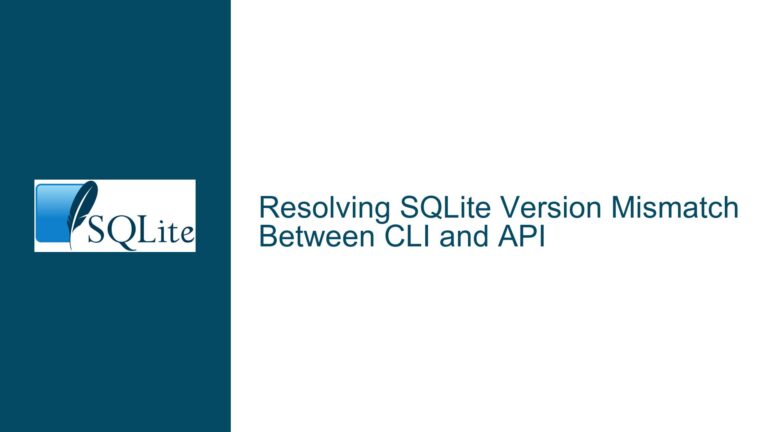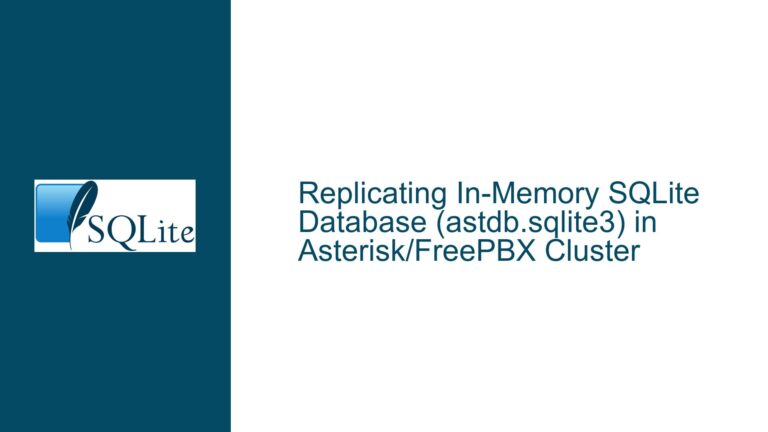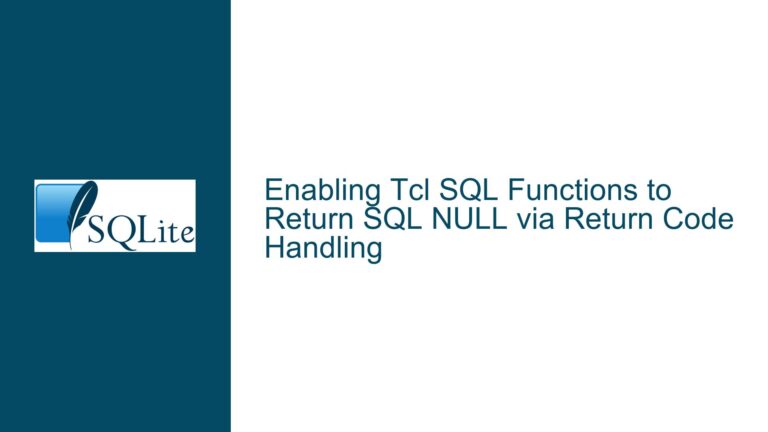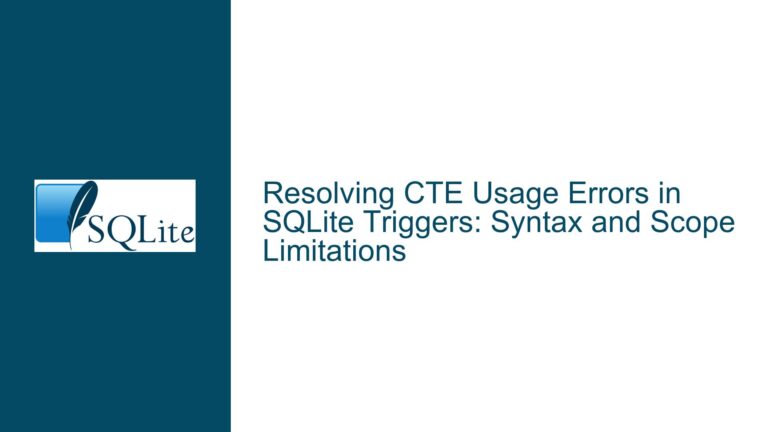SQLite Statement-Level Triggers: Limitations, Workarounds, and Future Considerations
SQLite’s Lack of Statement-Level Triggers and Its Impact on Application Design
SQLite, renowned for its lightweight and embedded nature, has long been a go-to database for applications requiring simplicity and portability. However, one notable limitation in SQLite is its lack of support for statement-level triggers. Unlike row-level triggers, which fire for each row affected by an SQL statement, statement-level triggers execute only once per statement, regardless of the number of rows impacted. This distinction is critical for applications that rely on efficient, constant-time operations, particularly when dealing with large datasets.
The absence of statement-level triggers in SQLite forces developers to rely on row-level triggers, which can lead to inefficiencies. For instance, if an SQL statement affects one million rows, a row-level trigger will fire one million times, whereas a statement-level trigger would fire only once. This discrepancy can result in significant performance overhead, especially in applications where bulk operations are common. Additionally, row-level triggers lack the ability to capture the "conclusion" of a statement, akin to how an aggregate function finalizes its computation at the end of a query. This limitation can complicate the implementation of certain application features that depend on the final state of a statement.
The impact of this limitation extends beyond performance. Applications that are designed with statement-level triggers in mind often rely on them for maintaining data integrity, enforcing business rules, or logging changes. In SQLite, developers must resort to workarounds, such as manually aggregating results within row-level triggers or using external application logic to simulate statement-level behavior. These workarounds not only increase the complexity of the code but also introduce potential points of failure, as they require careful synchronization between the database and the application layer.
Moreover, the assumption that SQLite is solely suited for embedded use cases overlooks its potential in more complex scenarios. Many developers use SQLite in environments where direct access to the database is necessary, such as through the official SQLite shell. In such cases, embedding as much logic as possible within the database itself is advantageous. The lack of statement-level triggers hinders this approach, forcing developers to offload logic to the application layer, which can lead to inconsistencies and reduced maintainability.
Technical Constraints and Design Philosophy Behind SQLite’s Trigger Implementation
The absence of statement-level triggers in SQLite is not an oversight but rather a deliberate design choice influenced by several technical and philosophical considerations. SQLite’s primary goal is to remain lightweight, simple, and easy to embed. Adding support for statement-level triggers would introduce additional complexity to the database engine, potentially compromising these core principles.
One of the key technical constraints is SQLite’s architecture, which is optimized for minimal resource usage. Statement-level triggers would require the database engine to maintain additional state information throughout the execution of an SQL statement. This state information would be necessary to determine when the statement has completed and to execute the trigger logic accordingly. Implementing such a feature would increase the memory footprint of SQLite and could impact its performance, particularly in resource-constrained environments.
Another consideration is SQLite’s transactional model, which is based on atomic commits and rollbacks. In SQLite, each SQL statement is executed within a transaction, either explicitly or implicitly. Row-level triggers align naturally with this model, as they operate within the context of individual row modifications. Statement-level triggers, on the other hand, would need to operate at a higher level of abstraction, potentially complicating the transactional semantics. For example, if a statement-level trigger were to fail, the database engine would need to ensure that all changes made by the statement are rolled back, including those that were processed by row-level triggers. This added complexity could introduce subtle bugs and make the database engine less predictable.
SQLite’s design philosophy also emphasizes simplicity and ease of use. The developers of SQLite have consistently prioritized features that provide the most value for the least complexity. While statement-level triggers are undoubtedly useful in certain scenarios, they are not essential for the majority of SQLite’s use cases. By omitting this feature, the SQLite team has been able to focus on other areas, such as improving performance, adding support for new SQL standards, and enhancing reliability.
Despite these constraints, the demand for statement-level triggers in SQLite is growing, particularly as the database is increasingly used in more complex applications. Developers who are accustomed to the feature-rich environments of other RDBMSs, such as PostgreSQL or MySQL, often find SQLite’s limitations frustrating. However, it is important to recognize that SQLite’s design choices are driven by a different set of priorities, and that these choices have contributed to its widespread adoption and success.
Workarounds, Best Practices, and Future Prospects for Statement-Level Triggers in SQLite
While SQLite does not natively support statement-level triggers, there are several workarounds and best practices that developers can employ to achieve similar functionality. These approaches vary in complexity and effectiveness, and the choice of which to use depends on the specific requirements of the application.
One common workaround is to use row-level triggers in combination with temporary tables or application-level state tracking. For example, a row-level trigger can be designed to insert relevant data into a temporary table each time it fires. Once the SQL statement has completed, the application can query the temporary table to aggregate the results and perform any necessary finalization. This approach effectively simulates the behavior of a statement-level trigger, albeit with additional overhead and complexity.
Another approach is to leverage SQLite’s AFTER and BEFORE trigger types to implement custom logic. For instance, a BEFORE trigger can be used to initialize state variables, while an AFTER trigger can be used to finalize the computation. This method requires careful coordination between the triggers and the application logic, but it can provide a reasonable approximation of statement-level behavior.
In some cases, it may be possible to refactor the application logic to reduce reliance on statement-level triggers. For example, instead of using triggers to enforce business rules or maintain data integrity, these tasks can be handled by the application layer. While this approach moves logic out of the database, it can simplify the database schema and make the application easier to maintain.
Looking to the future, there is ongoing discussion within the SQLite community about the potential addition of statement-level triggers. As SQLite continues to evolve and its use cases expand, the demand for more advanced features is likely to grow. However, any decision to add statement-level triggers would need to carefully balance the benefits against the added complexity and potential impact on SQLite’s core principles.
In the meantime, developers can stay informed about the latest developments in SQLite by following the official SQLite website and participating in community forums. By understanding the limitations and workarounds associated with statement-level triggers, developers can make informed decisions about how to best leverage SQLite in their applications.
In conclusion, while SQLite’s lack of statement-level triggers presents challenges for certain applications, there are viable workarounds and best practices that can mitigate these limitations. By carefully considering the trade-offs and exploring alternative approaches, developers can continue to harness the power and simplicity of SQLite in a wide range of use cases. As the database landscape evolves, it will be interesting to see how SQLite adapts to meet the changing needs of its users.






